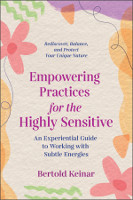
Image by Jerzy Górecki
There are many Highly Sensitive People (HSP) nowadays, walking around on our planet. Sensitivity is a complex situation that needs a complex approach. Well, complex in the sense of how many aspects of life it affects. But in another way, everything is simple.
Our reality is multidimensional and we are multidimensional creatures. But we try to solve problems from the perspective of linear thinking—in other words, only from the left hemisphere of the brain. This means that we are trying to solve problems within the boundaries and with the way of thinking that created them. Our society does not look to solve problems but to eliminate the symptoms so as to make the subject comfortable for society and productive for the economy.
Energetic Body Approach
Hypersensitivity, sensitivity and empathy do affect the physical body very much; however, as they come from our energetic bodies rather than the physical, they have to be addressed from this perspective. Sensitivity is a talent or a tool that is so strong that we see it as a part of a person’s nature or character. It cannot be taken away but it can be adjusted and controlled. The purpose of the tool we call sensitivity is to take in big amounts of information on a subtle level. It is a gift if we know how to use it, but a painful curse when we don’t.
The Western reader is accustomed to receiving a lot of information and explanations from books (this is a logical and left-side-of-the-brain approach). We believe that if we read about transformation then we will experience it. But too much information without practice is actually doing more harm than good. The left side of the brain—in fact, the whole brain—is just one of the ways we receive and analyze information.
For sensitive people, over engagement of the brain, particularly its left side, brings a lot of stress, discomfort and suffering. You must learn to do things from the perspectives you have, your sensitivity and beyond, step by step reducing the dominance of the left side of the brain. Remember, we reach understanding and knowledge through experience, not theory.
Sample Exercise: The (morning) candle
Time and duration:
First thing in the morning for 5 minutes.
What to do:
Take a simple candle, light it and put it in front of you (a hand to a hand-and-a-half away) and visualize it.
How to do it:
Take a few moments to memorize the candle. After you are sure you have an image of it, close your eyes and visualize the candle in the center of your head (don’t worry too much about locating the physical center). If you wish to be more accurate, visualize it at the pineal gland (again, don’t worry too much about physical accuracy).
When you have it there, look at it, let your concentration be on it. Stay on the image of the candle you have created in your mind for the whole period of 5 minutes. There has to be only silence and candle.
As you do it more, you should work on making the image of the candle more elaborate. Begin to see more details of the candle in the image you create in your mind. Details like texture, color, contours, and reflections.
What not to do:
-
Don’t fight or suppress your thoughts. Thoughts will come. Just keep concentrating on the candle. If you catch yourself daydreaming and led away by your stream of thoughts, just come back to the candle.
-
Don’t introduce distractions by combining it with other things — music, TV, meals or anything else.
-
Don’t do the exercise for more than 5 minutes, even if you only concentrated on the candle for 10 seconds and for the rest you were flying in the skies.
-
If a feeling appears, don’t switch your concentration to the feeling (even if it is a very pleasant one); stay on the image of the candle.
How and when do I know it’s working?
People who meditate or do other related practices will usually feel the effect kick in within three to five days.
For other people it will take a bit longer. I cannot really say how long. But just keep doing the exercise. If you don’t feel the effect, maybe you have put the image in the wrong place in your head, or you aren’t concentrating on the candle. Play with it till you find the right place. And keep working on concentrating on it. You train yourself by persistence and repetition.
It may sound like it will take months, but it won’t; it is a relatively easy and fast-working exercise.
Why am I doing it?
Sensitive people are sensitive because they feel energies, so they have to deal somehow with these energies. This exercise strengthens the concentration and awakens the organ that, together with the concentration, will control those energies. The power of concentration is the power of will, and the energies follow the will.
So very simple
Morning, candle, 5 minutes only, no distractions.
Copyright© 2022, Findhorn Press.
Printed with permission from the publisher
Inner Traditions International
Article Source:
BOOK: Empowering Practices for the Highly Sensitive
Empowering Practices for the Highly Sensitive: An Experiential Guide to Working with Subtle Energies
by Bertold Keinar  Allowing sensitives to stop sacrificing important parts of their unique nature in order to fit in, this guide supports empaths to become more comfortable with their heightened awareness, protect their energetic systems, and embrace full participation in society, where their gifts are sorely needed.
Allowing sensitives to stop sacrificing important parts of their unique nature in order to fit in, this guide supports empaths to become more comfortable with their heightened awareness, protect their energetic systems, and embrace full participation in society, where their gifts are sorely needed.
For more info and/or to order this book, click here. Also available as an Audiobook and a Kindle edition.
About the Author
 Bertold Keinar is a Reiki healer and a student of esoteric and mystic knowledge. He is dedicated to guiding sensitives through the difficulties of daily life and specializes in customizing esoteric techniques to help others. He lives in Bulgaria.
Bertold Keinar is a Reiki healer and a student of esoteric and mystic knowledge. He is dedicated to guiding sensitives through the difficulties of daily life and specializes in customizing esoteric techniques to help others. He lives in Bulgaria.
For more info, visit https://lea-academy.eu/en/lecturer/23/bertold-keinar/

























